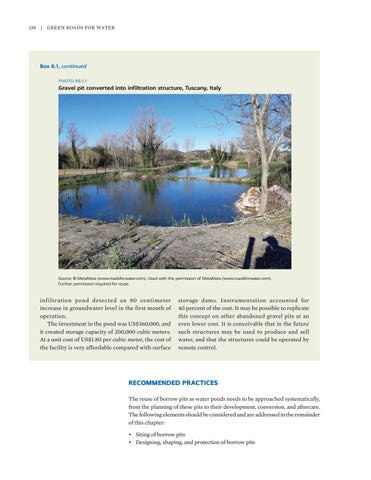138 | Green Roads for Water
Box 8.1, continued PHOTO B8.1.1
Gravel pit converted into infiltration structure, Tuscany, Italy
Source: © MetaMeta (www.roadsforwater.com). Used with the permission of MetaMeta (www.roadsforwater.com). Further permission required for reuse.
infiltration pond detected an 80 centimeter increase in groundwater level in the first month of operation. The investment in the pond was US$360,000, and it created storage capacity of 200,000 cubic meters. At a unit cost of US$1.80 per cubic meter, the cost of the facility is very affordable compared with surface
storage dams. Instrumentation accounted for 40 percent of the cost. It may be possible to replicate this concept on other abandoned gravel pits at an even lower cost. It is conceivable that in the future such structures may be used to produce and sell water, and that the structures could be operated by remote control.
RECOMMENDED PRACTICES The reuse of borrow pits as water ponds needs to be approached systematically, from the planning of these pits to their development, conversion, and aftercare. The following elements should be considered and are addressed in the remainder of this chapter: • Siting of borrow pits • Designing, shaping, and protection of borrow pits







































